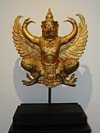|
Garuda (गरुड)
Sanskrit. A large and savage, firebreathing, mythological bird, mount of the Hindu god
Vishnu
(fig.),
with enough size to block out the sun and wings that create hurricane-like winds,
that darken the sky, and chant the
Vedas when
flying. He is the king of birds,
a son of
Kasyapa and Vinata, whose sister was Kadru, the mother of serpents,
thus making him a half-brother of the
nagas and snakes.
However, in a bid to liberate his mother Vinata, who had become enslaved to her
sister after losing a imprudent bet, he became the arch-enemy of the serpents. He is
usually depicted with a
golden body of a human and the wings and feet of a bird, and the beak of an
eagle
(fig.). He has a white face and a crown on his head and is in art often
shown in battle with a snake or naga (fig.), or sometimes flanked by a pair of nagas, a depiction in Thai referred to as
Phaya
Krut
yuk
Naak (fig.).
However, his depiction varies from country to country, and in some places he may
be portrayed with more human-like features (fig.). His birth and actions are told in the first book of the
epic
Mahabharata, where it is written that when he
first hatched, he appeared as a raging inferno equal to the cosmic blaze that
consumes the world at the end of every
yuga. Frightened, the gods
begged for mercy, whereupon Garuda reduced himself in size and force.
The flaming nimbus usually depicted with Fudo Myoo (fig.), also known as
Budong (fig.) and
Acalanatha (fig.), is said to be the flame of the Garuda and in
iconography, the features of a bird can hence sometimes be discovered entangled in those flames (fig.).
In the
Vedas, where he is mentioned the first time, he is
said to have brought nectar from heaven to earth. In
Hinduism, worship of Garuda is believed
to remove the effects of poisons from one's body.
Krishna (fig.) carries the image of
Garuda on his banner and in Thailand, he is since 1911 the nation's royal symbol, replacing the unofficial coat of arms of the Kingdom of
Siam (fig.), while showing the connection between the Thai monarch as the protector of the nation, and the mighty god Vishnu as the protector of the universe. In line with this, the Garuda is also the emblem of the Civil Service, whose flag consists a white field with a golden Garuda (fig.), and whose members wear it on the buckle of their uniform belts, akin to members of the
Royal Thai Police and the
Royal Thai Armed Forces. A red Garuda over a green
banner with the golden inscription Dooy Dai Rap
Phra Boromma Racha Anuyaht,
i.e. ‘By (having received) Royal Permission’ is a Royal Warrant of Appointment
given by the King of Thailand to any purveyor to the royal household or to
someone who or a business that has shown exceptional services and commitment to
the development of the nation, and is known as
Krut Trah Tang Hahng (fig.). Garuda has six sons from whom the race of birds descended. In Buddhism, garudas are
huge and intelligent predatory birds with social order, and believed to dwell in
silk cotton trees (fig.).
In 1924, his image was portrayed on the nation's first ever issue of airmail
postage stamps (fig.)
and he somewhat became the unofficial emblem of the Thai Post in its early form,
before the establishment of the
Thailand Post Public Company Limited
in 2003, and appears in several forms
on the
General Post Office Building in Bangkok
(fig.), sometimes depicted holding a post horn (fig.).
There is a rather unique Garuda shrine, known as Sahn Chao Pho Khrut (fig.), tucked away in
a short and narrow street in
Bangkok's Phra Nakhon District. He is also known by the names Chirada, Gaganeshvara, Galohn (fig.), Kamayusha, Karura,
Kashyapi, Khageshvara, Khangard, Nagantaka, Shyena (eagle), Sitanana, Sudhahara,
Suban, Suparna or Supanna (well-winged), Tarkshya, Vainateya, Vineeta,
Vishnuratha
(ratha
or chariot of Vishnu), etc. See also
look lep krut
(fig.).
See also THEMATIC STREET LIGHT
and WATCH VIDEO (1) and (2).
回






|

